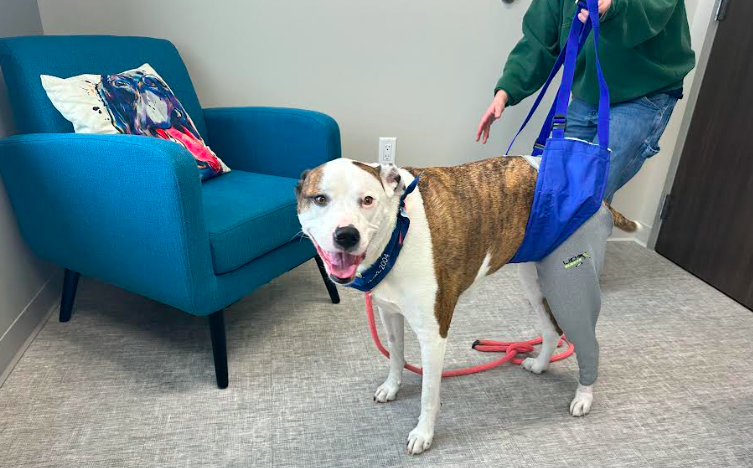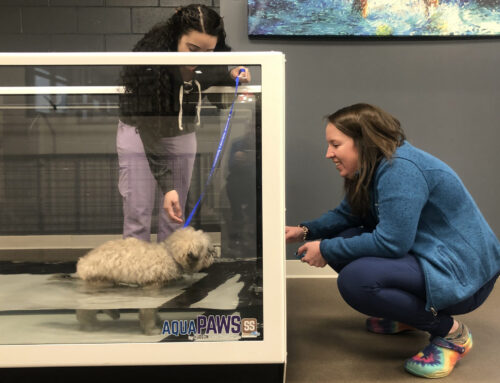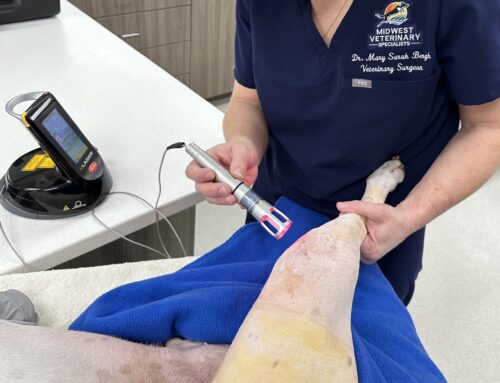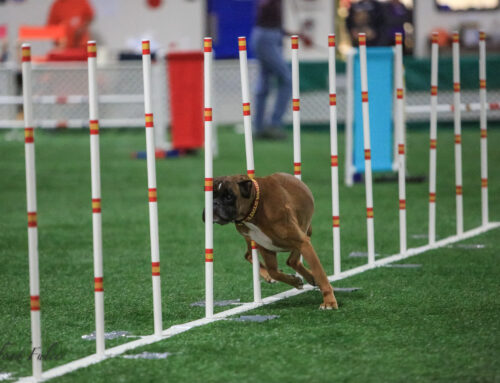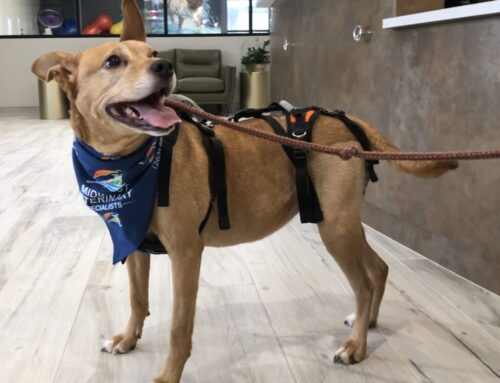When a dog’s cranial cruciate ligament (CCL) ruptures, their stifle (i.e., knee) loses stability, causing pain and decreased mobility. The medial meniscus can then become torn, and osteoarthritis will develop if the joint isn’t stabilized, which can result in chronic, debilitating discomfort. Tibial plateau leveling osteotomy (TPLO) is a surgical technique for stabilizing joints with CCL damage so the dog can return to normal function. The procedure also slows arthritis progression in the joint. Our board-certified surgeons at Midwest Veterinary Specialists are specially trained to perform this advanced surgical procedure, and are available if your dog requires CCL surgery.
What causes cranial cruciate ligament rupture in dogs?
Imagine this common scenario: You are enjoying an energetic game of frisbee with your four-legged friend. Your dog races, turns mid-stride for a beautiful catch, and then yelps and holds up their right hind limb when they land. Your best pal has just torn his CCL. While acute trauma to an otherwise normal CCL might seem like the obvious cause, it may surprise you to learn that the most common reason for a CCL rupture is chronic degeneration. In other words, the ligament was already degenerating before the sudden force of landing caused it to rupture all the way. The degeneration of the CCL has been shown to be associated with factors such as genetics, early spaying and neutering, physical condition, conformation, and breed. Breeds at higher risk include rottweilers, Newfoundlands, Labrador retrievers, Chesapeake Bay retrievers, and Saint Bernards. CCL rupture is also commonly diagnosed in large and small-breed dogs affected by medial patellar luxation.
What is tibial plateau leveling osteotomy for dogs?
CCL rupture is the most common orthopedic disease in dogs, and veterinarians developed surgical techniques in the early 1960s that attempted to replace the damaged ligament. Unfortunately, those methods failed to adequately stabilize the knee, and significant arthritis developed.
In the 1980s, Dr. Barclay Slocum, a veterinarian whose father was a human orthopedic surgeon, decided to examine the problem. He studied the dynamic forces that affected the canine knee during weight-bearing and movement when the CCL was torn, and noticed that the angle of the slope at the top of the tibia was greater in joints affected by CCL rupture. He theorized that flattening the slope would be more effective than replacing the damaged ligament. He accomplished this by cutting the top of the tibia and rotating it to flatten it, creating the desired flattened tibial plateau angle, a technique that came to be known as the tibial plateau leveling osteotomy (TPLO).
The cut in the tibia is based on calculations made from X-rays taken before surgery, and bone plates and screws are used to hold the bone in position while it heals. In addition to the tibial cut, during a typical TPLO procedure, the inside of the joint is carefully inspected, because meniscus injuries are common when the CCL ruptures, and this damaged tissue must be removed or repaired to improve the dog’s prognosis.
What dogs are candidates for tibial plateau leveling osteotomy?
If your dog has either a partial or a complete CCL rupture, then they are a candidate for TPLO surgery. While other surgical and nonsurgical treatment methods could be considered, the TPLO is the only surgical procedure that has been shown to consistently allow dogs to return to normal clinical function—regardless of their size. There is no need to wait for the CCL to completely tear in order to be a candidate for surgery. In fact, studies have shown that clinical function and overall joint health is better in both the short and long term for dogs with stable, partial CCL tears compared to complete CCL tears. Also, the earlier that surgery is performed, the less likely there is meniscus damage—a factor which can also improve joint health and stability.
Who should perform my dog’s TPLO?
In veterinary medicine, you no doubt have many options to consider. We recommend utilizing an experienced board certified surgeon with lots of experience in TPLO surgery. Board certified surgeons, like those at Midwest Veterinary Specialists, undergo years of specialized training in surgery and anesthesia that will maximize the chances of a successful outcome. In fact, studies have shown that outcomes are better and complications are fewer when an experienced surgeon performs the operation. In addition, board certified surgeons are much more likely to be able to offer minimally invasive options such as arthroscopy, which can optimize joint evaluation and decrease pain for your pet.
What post-surgical care will my dog need?
Post operative care should be considered prior to TPLO surgery, as it is so important to maximize the outcome and minimize the chances of complications post-operatively. Every case is different, and your dog’s post-surgical plan will be customized to their specific situation. General factors include:
- Confinement — Your dog should be strictly confined for at least eight weeks after surgery. Running, jumping, navigating stairs, and slippery floors should be avoided during this time. Controlled leash walks are allowed in increasing duration, as the healing progresses.
- Physical therapy — Physical rehabilitation exercises can facilitate healing and improve final outcomes. Initially, passive range of motion exercises and short, controlled leash walks are used to encourage joint movement, followed by balance exercises, weight-shifting exercises, and water treadmill sessions, to help strengthen muscles and improve joint function.
- Pain management — Adequate pain management is important, so your dog will move their joint in the early stages following surgery. At Midwest Veterinary Specialists, we approach pain from many different directions to make sure your pet is as comfortable as possible during and after surgery.
- Weight management — Excess pounds put unnecessary stress on the healing joint, so weight loss may be needed. Even healthy weight dogs should have their dietary intake reduced to prevent weight gain while they are exercise-restricted in the recovery period.
- Rechecks — Your dog will need follow-up examinations and X-rays to assess bone healing and determine their ability for increased activity level.
What is the prognosis for dogs undergoing tibial plateau leveling osteotomy?
The long-term prognosis for dogs who undergo TPLO surgery is good to excellent: Greater than 90-95% of dogs return to their normal or ‘pre-injury’ level of activity. Any dog who experiences a CCL rupture is likely to develop arthritis, but TPLO may slow the progression of it. Unfortunately, 40% to 60% of dogs who experience a CCL rupture in one stifle develop a CCL rupture in the contralateral limb at some point in the future, so ongoing monitoring is recommended.
TPLO is a beneficial surgery for most dogs affected by a CCL rupture. If your dog is experiencing hind limb lameness, contact our Midwest Veterinary Specialists team to determine whether TPLO surgery is right for them.


